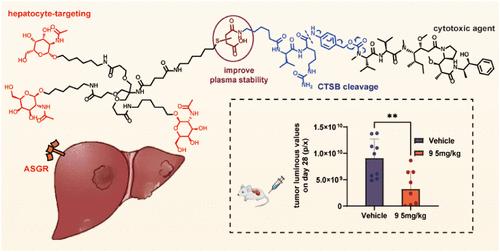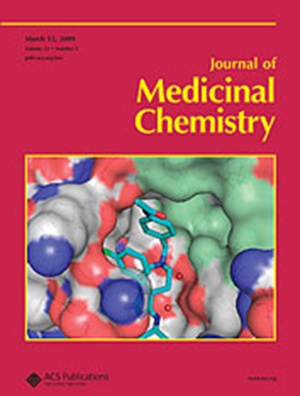Development of ASGR-Mediated Hepatocyte-Targeting Cytotoxic Drug Conjugates with CTSB-Cleavable Linkers Incorporating Succinimide and Succinic Acid Monoamide
IF 6.8
1区 医学
Q1 CHEMISTRY, MEDICINAL
引用次数: 0
Abstract
The ASGR-mediated endocytosis has been successfully applied to the hepatocyte-targeted delivery of therapeutic oligonucleotides via glycoconjugates. However, few studies have explored the conjugated small molecules due to the challenge of cleaving suitable linkers for the release of active small molecules, which is especially different from GalNAc-ONs cleaved by the deoxyribonuclease II in the lysosome. In this study, GalNAc-MMAE conjugates linked by CTSB-cleavable linkers were designed and synthesized. A comprehensive approach revealed that the conjugates were endocytosed by ASGR and subsequently hydrolyzed by CTSB, releasing MMAE. The optimized conjugate with a succinic acid monoamide as the fragment of the linker demonstrated favorable plasma stability, excellent biodistribution, and significant antitumor activities in vivo with weight gain at the effective dose in an orthotopic hepatocellular carcinoma mouse model. This research provides a strategy for developing anti-HCC therapeutic agents using GalNAc drug conjugates with CTSB-cleavable linkers to release active small molecules.

求助全文
约1分钟内获得全文
求助全文
来源期刊

Journal of Medicinal Chemistry
医学-医药化学
CiteScore
4.00
自引率
11.00%
发文量
804
审稿时长
1.9 months
期刊介绍:
The Journal of Medicinal Chemistry is a prestigious biweekly peer-reviewed publication that focuses on the multifaceted field of medicinal chemistry. Since its inception in 1959 as the Journal of Medicinal and Pharmaceutical Chemistry, it has evolved to become a cornerstone in the dissemination of research findings related to the design, synthesis, and development of therapeutic agents.
The Journal of Medicinal Chemistry is recognized for its significant impact in the scientific community, as evidenced by its 2022 impact factor of 7.3. This metric reflects the journal's influence and the importance of its content in shaping the future of drug discovery and development. The journal serves as a vital resource for chemists, pharmacologists, and other researchers interested in the molecular mechanisms of drug action and the optimization of therapeutic compounds.
 求助内容:
求助内容: 应助结果提醒方式:
应助结果提醒方式:


